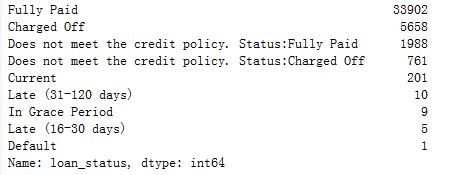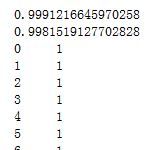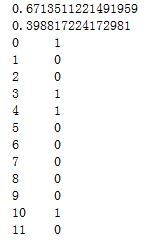贷款利润最大化——利用随机森林和逻辑回归进行分类
1.数据读取
这里有一份贷款数据,包括与贷款相关信息,现有主要任务:对贷款人借贷状态(全额借贷、不予借贷)进行分类,从而实现贷款利润最大化。
import pandas as pd
loans_2007 = pd.read_csv('LoanStats3a.csv', skiprows=1)
half_count = len(loans_2007) / 2
#删除空值记录
loans_2007 = loans_2007.dropna(thresh=half_count, axis=1)
#舍弃无关字段
loans_2007 = loans_2007.drop(['desc', 'url'],axis=1)
#将清理的数据集存入新的csv文件中
loans_2007.to_csv('loans_2007.csv', index=False)
import pandas as pd
loans_2007 = pd.read_csv("loans_2007.csv")
print(loans_2007.iloc[0])
print(loans_2007.shape[1])
输出结果显示共有52个字段,其中部分字段为无关字段,应该舍弃。
2.数据清洗及分析
loans_2007 = loans_2007.drop(["id", "member_id", "funded_amnt", "funded_amnt_inv", "grade", "sub_grade", "emp_title", "issue_d"], axis=1)
loans_2007 = loans_2007.drop(["zip_code", "out_prncp", "out_prncp_inv", "total_pymnt", "total_pymnt_inv", "total_rec_prncp"], axis=1)
loans_2007 = loans_2007.drop(["total_rec_int", "total_rec_late_fee", "recoveries", "collection_recovery_fee", "last_pymnt_d", "last_pymnt_amnt"], axis=1)
print(loans_2007.iloc[0])
print(loans_2007.shape[1])
删除无关字段后,剩余32个字段
#统计不同还款状态对应的样本数量——标签类分析
print(loans_2007['loan_status'].value_counts())

统计结果显示,共有9种借贷状态,其中我们仅分析"Fully Paid"(全额借款)和"Charged Off"(不借款)这两种状态。
#筛选出要分类的标签值,其中"Fully Paid"状态值为1,"Charged Off"状态值为0
loans_2007 = loans_2007[(loans_2007['loan_status'] == "Fully Paid") | (loans_2007['loan_status'] == "Charged Off")]
status_replace = {
"loan_status" : {
"Fully Paid": 1,
"Charged Off": 0,
}
}
loans_2007 = loans_2007.replace(status_replace)
在进行数据分析时,部分字段对应的值只有一个,应删除这些无关字段
orig_columns = loans_2007.columns
drop_columns = []
for col in orig_columns:
col_series = loans_2007[col].dropna().unique()
#如果字段值都一样,删除该字段
if len(col_series) == 1:
drop_columns.append(col)
loans_2007 = loans_2007.drop(drop_columns, axis=1)
print(drop_columns)
print loans_2007.shape
#将清洗后数据存入一个新的文件中
loans_2007.to_csv('filtered_loans_2007.csv', index=False)
import pandas as pd
loans = pd.read_csv('filtered_loans_2007.csv')
loans = loans.drop("pub_rec_bankruptcies", axis=1)
#删除包含空值的记录
loans = loans.dropna(axis=0)
print(loans.dtypes.value_counts())
loans = loans.drop("pub_rec_bankruptcies", axis=1)
loans = loans.dropna(axis=0)
#统计不同数据类型下的字段总和
print(loans.dtypes.value_counts())
输出结果如下图,12个列所对应的数据类型为字符型,应转化为数值型。

#输出数据类型为字符型的字段
object_columns_df = loans.select_dtypes(include=["object"])
print(object_columns_df.iloc[0])
#对字符型数据进行分组计数
cols = ['home_ownership', 'verification_status', 'emp_length', 'term', 'addr_state']
for c in cols:
print(loans[c].value_counts())
print(loans["purpose"].value_counts())
print(loans["title"].value_counts())
进一步进行数据清洗
#将"emp_length"字段转化为字符型数据
mapping_dict = {
"emp_length": {
"10+ years": 10,
"9 years": 9,
"8 years": 8,
"7 years": 7,
"6 years": 6,
"5 years": 5,
"4 years": 4,
"3 years": 3,
"2 years": 2,
"1 year": 1,
"< 1 year": 0,
"n/a": 0
}
}
loans = loans.drop(["last_credit_pull_d", "earliest_cr_line", "addr_state", "title"], axis=1)
#将百分比类型转化为浮点型(小数类型)
loans["int_rate"] = loans["int_rate"].str.rstrip("%").astype("float")
loans["revol_util"] = loans["revol_util"].str.rstrip("%").astype("float")
loans = loans.replace(mapping_dict)
cat_columns = ["home_ownership", "verification_status", "emp_length", "purpose", "term"]
dummy_df = pd.get_dummies(loans[cat_columns])
loans = pd.concat([loans, dummy_df], axis=1)
loans = loans.drop(cat_columns, axis=1)
loans = loans.drop("pymnt_plan", axis=1)
loans.to_csv('cleaned_loans2007.csv', index=False)
import pandas as pd
#读取最终清洗的数据
loans = pd.read_csv("cleaned_loans2007.csv")
print(loans.info())
最终数据包含的字段如下:
| loan_amnt | 38428 non-null float64 |
|---|---|
| installment | 38428 non-null float64 |
| int_rate | 38428 non-null float64 |
| annual_inc | 38428 non-null float64 |
| loan_status | 38428 non-null float64 |
| dti | 38428 non-null float64 |
| delinq_2yrs | 38428 non-null float64 |
| inq_last_6mths | 38428 non-null float64 |
| open_acc | 38428 non-null float64 |
| pub_rec | 38428 non-null float64 |
| revol_bal | 38428 non-null float64 |
| revol_util | 38428 non-null float64 |
| total_acc | 38428 non-null float64 |
| home_ownership_MORTGAGE | 38428 non-null float64 |
| home_ownership_NONE | 38428 non-null float64 |
| `````` | ``````` |
3.建立逻辑回归模型,预测是否借贷
在这里我们分别建立了三个模型,比较不同模型的训练效果
#利用逻辑回归模型对0-1标签进行分类
from sklearn.linear_model import LogisticRegression
from sklearn.cross_validation import cross_val_predict, KFold
lr = LogisticRegression()
kf = KFold(features.shape[0], random_state=1)
predictions = cross_val_predict(lr, features, target, cv=kf)
predictions = pd.Series(predictions)
#负例预测为正例
fp_filter = (predictions == 1) & (loans["loan_status"] == 0)
fp = len(predictions[fp_filter])
# 正例预测为正例
tp_filter = (predictions == 1) & (loans["loan_status"] == 1)
tp = len(predictions[tp_filter])
# 负例预测为正例
fn_filter = (predictions == 0) & (loans["loan_status"] == 1)
fn = len(predictions[fn_filter])
# 负例预测为负例
tn_filter = (predictions == 0) & (loans["loan_status"] == 0)
tn = len(predictions[tn_filter])
# 统计指标:tpr和fpr,其中tpr越大越好,fpr越小越好
tpr = tp / float((tp + fn))
fpr = fp / float((fp + tn))
print(tpr)
print(fpr)
print(predictions[:20])
输出如下:

此时tpr和fpr比例均较高,不满足要求;进一步调整参数class_weight,使得正负样本比例得到均衡
#在正负样本比例均衡条件下训练模型,统计相关指标
from sklearn.linear_model import LogisticRegression
from sklearn.cross_validation import cross_val_predict
lr = LogisticRegression(class_weight="balanced")
kf = KFold(features.shape[0], random_state=1)
predictions = cross_val_predict(lr, features, target, cv=kf)
predictions = pd.Series(predictions)
#负例预测为正例
fp_filter = (predictions == 1) & (loans["loan_status"] == 0)
fp = len(predictions[fp_filter])
# 正例预测为正例
tp_filter = (predictions == 1) & (loans["loan_status"] == 1)
tp = len(predictions[tp_filter])
# 负例预测为正例
fn_filter = (predictions == 0) & (loans["loan_status"] == 1)
fn = len(predictions[fn_filter])
# 负例预测为负例
tn_filter = (predictions == 0) & (loans["loan_status"] == 0)
tn = len(predictions[tn_filter])
# 统计指标:tpr和fpr,其中tpr越大越好,fpr越小越好
tpr = tp / float((tp + fn))
fpr = fp / float((fp + tn))
print(tpr)
print(fpr)
print(predictions[:20])
from sklearn.linear_model import LogisticRegression
from sklearn.cross_validation import cross_val_predict
#因为这里负例样本数量远远小于正例样本数量,我们可以调整正负样本的权重,使得正负样本比例均衡
penalty = {
0: 5,
1: 1
}
lr = LogisticRegression(class_weight=penalty)
kf = KFold(features.shape[0], random_state=1)
predictions = cross_val_predict(lr, features, target, cv=kf)
predictions = pd.Series(predictions)
#负例预测为正例
fp_filter = (predictions == 1) & (loans["loan_status"] == 0)
fp = len(predictions[fp_filter])
# 正例预测为正例
tp_filter = (predictions == 1) & (loans["loan_status"] == 1)
tp = len(predictions[tp_filter])
# 负例预测为正例
fn_filter = (predictions == 0) & (loans["loan_status"] == 1)
fn = len(predictions[fn_filter])
# 负例预测为负例
tn_filter = (predictions == 0) & (loans["loan_status"] == 0)
tn = len(predictions[tn_filter])
# 统计指标:tpr和fpr,其中tpr越大越好,fpr越小越好
tpr = tp / float((tp + fn))
fpr = fp / float((fp + tn))
print(tpr)
print(fpr)
print(predictions[:20])
4.建立随机森林模型
from sklearn.ensemble import RandomForestClassifier
from sklearn.cross_validation import cross_val_predict
rf = RandomForestClassifier(n_estimators=10,class_weight="balanced", random_state=1)
#print help(RandomForestClassifier)
kf = KFold(features.shape[0], random_state=1)
predictions = cross_val_predict(rf, features, target, cv=kf)
predictions = pd.Series(predictions)
# False positives.
fp_filter = (predictions == 1) & (loans["loan_status"] == 0)
fp = len(predictions[fp_filter])
# True positives.
tp_filter = (predictions == 1) & (loans["loan_status"] == 1)
tp = len(predictions[tp_filter])
# False negatives.
fn_filter = (predictions == 0) & (loans["loan_status"] == 1)
fn = len(predictions[fn_filter])
# True negatives
tn_filter = (predictions == 0) & (loans["loan_status"] == 0)
tn = len(predictions[tn_filter])
# Rates
tpr = tp / float((tp + fn))
fpr = fp / float((fp + tn))
输出结果如下

在这里我们得到随机森林模型效果劣于逻辑回归模型的效果
相关数据集如下:链接:https://pan.baidu.com/s/1CezGYZAR1Zs-8_WIo2-TrA
提取码:wmvq
